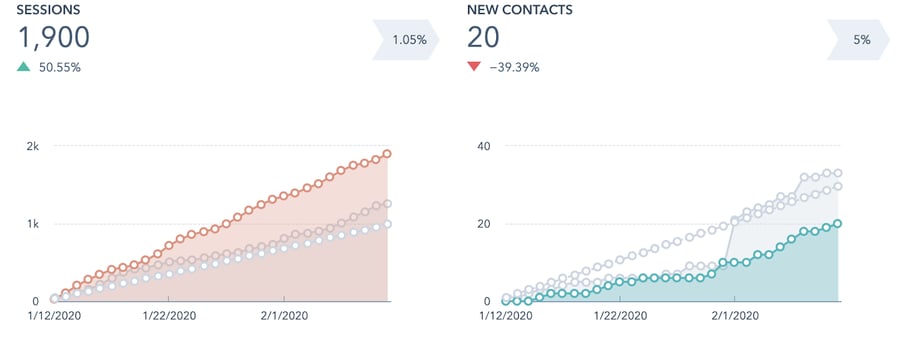A lot of our clients care deeply about the leads that they're generating and the quality of those leads. (We always say if it doesn't make money, it doesn't make sense.)
Having website traffic is great, but you want to keep pushing those users down the marketing funnel to become a lead and eventually become a paying customer. In this article, find out the true meaning of what a lead is, lead generation strategy, and proven methods to capture more leads.
The True Meaning of a Lead
One of the things that we get asked the most is what's the difference between a visitor and a lead? If you've got 1,900 people coming to your website. That's great. But what does that mean as far as marketing and sales? All in all website traffic is important, but it's not everything.

At LAIRE, we love seeing traffic increase, but if that increased traffic is not qualified, relevant traffic, it doesn't do your company any good.
As marketers, we want to make sure that the people who are coming to your website are people who are actually going to be interested and engaged. We want to also include conversion opportunities across your site so that those people — the relevant, interested people who really could benefit from your product or service — have a chance to convert and become actionable leads.
What's the Difference? Lead vs Visitor
A lead is anybody who's interacted on your website and given your company more information about themselves. A website visitor is somebody who's come to the site but might not actually be interested in your product or services. Here is an example of how someone goes from being a visitor to a lead.
Example: Maybe on one of your blogs, a user sees a downloadable guide that interests them and gives them a little bit more information about whatever problem they're trying to solve. In exchange for getting the guide, they give you some high-level information. They may give you their name, email, and company name on a form on a landing page. After giving over this additional information about themselves, they will then be converted to a lead in your system.
Lead Generation Through the Inbound Methodology
At the heart of the inbound approach is relevant, educational content. Content is a useful tool to utilize to attract your ideal audience and convert them into leads. Let's look at a real-life example of how content is used to bring more leads to your site.
Example: If somebody you know has a problem, they will probably turn to Google for help. Do they have a bump on their arm? They've already probably thought through all the possibilities of what could have caused the bump. By giving them a helpful resource on a search engine about what could have caused the bump, you now have the opportunity to provide them with a solution to their problem after they've landed on your site. There are all kinds of different ways to bring people to your site, but having helpful, relevant content is a great place to start.
Lead Generation Strategy
We like to use the term "lead generation strategy" when building websites and the website's foundation. But under the strategy umbrella, you should also be considering what your overall goal is.
When you're creating a website, you're not just creating it to be this beautiful website. You can have the most beautiful website in the world but if people don't find it, then it doesn't make any sense. So, how do you create a lead generation strategy?
How to Create a Lead Generation Strategy
- Look at the analytics: Start by looking to see how much traffic is getting to the site. What are the keywords that the site is already ranking for? Are there gaps? Are there holes in content that need to be filled?
- Create a content plan: To come up with content ideas, target relevant keywords that will get your site good, qualified traffic. As you are starting out, you may want to capitalize on keywords that have lower monthly volume and difficulty scores for your content to pick up steam. After you have had steady traffic for a while, then you can begin to target those more difficult keywords. Remember: Marketing efforts take time. Sometimes it takes a while for blogs, content offers, and website pages to "catch fire."
- Identify conversion opportunities: If you're not converting, that's a problem. Start by looking at areas on the website where we can add conversion opportunities. Now, taking a step back from that, do you have any content for people to convert with? If you don't have any downloadable content or anything that we call a gated offer on the website, we would want to start there first. You will want to give visitors something of value that people would want to exchange for their personal information to allow them to convert into leads.
- Execute your strategy: Having a strategy is great, but at the end of the day, you have to execute. If you don't execute as a marketer, you won't be able to reap the benefits of your marketing strategy.
Example of a Lead Generation Strategy in Action
At LAIRE, we've been working on a new company that has a fast product platform. When entering into these conversations, we know at a high level the things that we need to pull together to make our marketing efforts successful. These things include data, a content strategy, customer pain points, and understanding the business's unique definition of a qualified lead.
The Journey to Creating a Lead Generation Strategy
- When creating a lead generation strategy, we always start by looking at the data for content ideas. (The numbers don't lie, and it is a good baseline to look at before jumping into any marketing initiatives.) What are the questions your ideal customers have about your products or services? Can you convert that into a blog or a content offer?
- Then, we ask ourselves about the customer's pain points. What are they looking for? What are their problems? What do they need? What do you need to help you be more successful in your sales?
- After that, we partner with the sales team to figure out what a qualified lead looks like for their business. What qualities do those potential buyers have? What do they come in struggling with? Oftentimes businesses think, "Oh! We can serve anyone and everyone. Everybody's a good customer!" But at the end of the day, that's not true. And, the businesses that are really successful know exactly who their end target is.
Now, let's talk about some tactical tips your team can use to produce successful lead generation campaigns.
Tactical Tips for Lead Generation
1. Perform Keyword Research
Let's say you are a marketing automation platform. You can try and go after the keyword "marketing automation platform." But, that is an extremely highly competitive keyword. It's also very broad. So, instead of using the keyword "marketing automation platform," you may want to try and capitalize on some deeper, segmented searches like "marketing automation platform for technology" or "marketing automation platform that does X." Those keywords are what we call long-tail keywords. They typically have a lower search volume but the intent is a lot higher.
2. Utilize FAQ Pages
By capturing Frequently Asked Questions (FAQ) that your customers have, you can create an FAQ page to answer the questions customers usually have about your product or service. This will help both your potential customers and sales team with answering all the necessary questions before starting a sales conversation.
3. Know Your Marketing Budget
The one major thing to consider with all of your marketing efforts is going to be that ugly B-word: budget. What is your marketing budget for the year? Are you setting aside enough money for marketing? Are you using that marketing budget to the best of your ability?
4. Get Customer Feedback
By collecting customer feedback, you can take customer pain points and fix problems as you're getting feedback. Instead of letting problems go unresolved for a long period of time, it's good to ask your customer base how you can do better as a company to enhance their experience and help you bring in more customers in the long run.
5. Use Email Marketing
What you have to do in terms of competitive advantage is to make sure that you're taking as many of the opportunities as you can to nurture your prospects. Email is a great way to do that. If your competitor is doing email marketing automation and you're not, there's a gap that needs to be filled. With email marketing, you can send more relevant, educational content to prospects to help them decide if your products or services are a fit for them.
So, we've discussed the differences between a lead and a visitor, and we touched on the actionable ways you can create a lead generating strategy. Next, let's talk about the digital marketing metrics you should look at to determine if your lead generating campaigns are succeeding or not.
Digital Marketing Reporting & ROI
One of the worst things you could do is to set up a marketing campaign and forget it in hopes that it's performing. We can't tell you how many times we've started working with a company that has a live campaign, but they haven't tracked its performance. As a marketer, it's critical to go back and look at your campaign metrics. Here are some of the metrics you should and shouldn't look at to project campaign success.
What Marketing Metrics Should You NOT Look At?
Let's start by discussing vanity metrics and why they aren't an indicator of marketing success. Vanity metrics are metrics like impressions, page views, social media likes, and trial users.
They're nice numbers to have. And when they're increasing, it feels great! But it doesn't necessarily mean that your marketing is working because it doesn't necessarily give you anything you can tweak or change to improve upon. All in all, vanity metrics don't give you the kind of information you can act on. So, what KPIs should your team look at?
Marketing KPIs You Need to Track
When you're trying to come up with KPIs, you really want to track KPIs that align with your SMART goals. SMART goals are goals that are Specific, Measurable, Achievable, Realistic, and Timely. You don't want to just say "Someday we want to have 100 contacts in our list." That goal isn't specific or timely. A better goal would be "We want to have 100 contacts from organic search by December."
After setting your SMART goals, it's time to decide what metrics will help you track those goals.
Here are some common metrics marketers track to capture website growth:
- Lead to Customer Ratio: If your marketing team is bringing in leads but the sales team isn't closing them or believes that the leads are unqualified, we should change the messaging that we're using or add in other layers to qualify them better. As marketers, we don't want the sales team to waste their time with unqualified leads. Aligning your sales and marketing efforts is essential for business success, and having ongoing conversations with your sales team will enable more revenue for your business.
- Organic Traffic Sessions: Organic traffic is the kind of traffic that you get organically through searches. We sometimes like to call it free traffic because you're not paying Google or Facebook to get that traffic. If your site is ranking higher in Google search, you will in turn be more likely to have more sessions. You can increase your organic sessions by writing relevant, long-form content that meets search intent.
- Landing Page Conversion Rate: You want to make sure that your landing pages are converting. If you're doing paid ads and you're sending the visitor to a landing page to download a content offer for your product or service, you want to make sure that your audience is actually converting on the page. If there are many landing page sessions but you have a low conversion rate, you may need to optimize the ad or landing page messaging to be cohesive with the content offer you are providing.
- Cost Per Lead: How much is a lead costing your business? By calculating the average lead cost, your team will be able to present C-level executives with information about their Return on Investment and the value of marketing.
Capture More Leads with Inbound Marketing
If you are having issues capturing leads, there are different tactics you can utilize to convert leads on your site. Whether you need to add more conversion opportunities or you need to tweak your website's messaging to hit on customer pain points, there is always room for improvement.
If you're ready to bring in more leads, download the "How to Run an Inbound Campaign" Checklist to create a growth-driven campaign that works.

